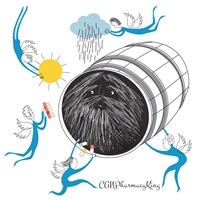

Any clear space of floor was strewn with cat and dog feces. There was no kitchen sink in sight, and it looked as if some dishes were being cleaned in the toilet (see Figures The house was crammed with filthy clothes, garbage, dirty dishes, and rotting food. Upon entering the house, it was found to be in complete disarray. The following day she was adamant about having to go feed her cats and dogs, and eventually gave permission for a Community Mental Health Nurse enter her house to attend to her pets. She was re-started on her previous psychiatric medication, namely divalproex and clonazepam. Vitamin B12 was on the low end of normal. Thyroid stimulating hormone was slightly elevated, although T4 was within normal limits. Complete blood count, electrolytes, glucose, liver function, and lipid profile were all within normal limits. She was diagnosed with having a manic relapse secondary to non-adherence to medication, and was involuntarily admitted to the in-patient psychiatric ward. She had no insight, and refused any form of treatment. She was very agitated, and was verbally and physically abusive to staff. She was disheveled, unkempt, wearing dirty clothes, and was foul smelling. She was found to have pressured speech, elated mood, increased energy, and very poor personal hygiene. Keeping this constellation of symptoms in mind will allow for a more prompt diagnosis and initiation of management of these clients.Ī 61-year-old obese Caucasian female with a previous history of bipolar 1 disorder and hypothyroidism, presented for an out-patient psychiatric follow-up review accompanied by her Community Psychiatry Nurse. This paper identifies that these patients can present due to a variety of reasons, and sometimes only by chance. This can make specific causes of death difficult to determine These individuals self-isolate, and therefore may not be found until much later post-mortem. This is subsequent to self-neglect, poor infection control practices, nutritional deficiency, and lack of presentation to medical care. , which is commonly due to physical illnesses such as pneumonia.

Mortality is increased in these patients, with a 46% five-year death rate Syllogomania is differentiated from Diogenes in that other characteristics such as the squalor and neglect are present in DS
#Diogenes disorder manual#
, while others state that chronic mania symptoms, such as poor insight, can lead to such a conditionĪlthough DS is not uniquely recognized in the Diagnostic and Statistical Manual (DSM) of Mental Disorders, the fifth version of the manual now identifies hoarding (syllogomania), as a psychiatric diagnosis There are suggestions that an orbitofrontal brain lesion may lead to such behaviours While no clear etiology exists, it is hypothesized that it may be due to a stress reaction in people with certain pre-morbid personality traits, such as being aloof, or certain personality disorders, such as schizotypal or obsessive compulsive personality disorder It is often associated with other mental illnesses, such as schizophrenia, mania, and frontotemporal dementia Affected individuals come from any socioeconomic status, but are usually of average or above-average intelligence The approximate annual incidence of Diogenes is 0.05% in people over the age of 60 Diogenes syndrome (DS) is a behavioural disorder characterized by domestic filth, or squalor, extreme self-neglect, hoarding, and lack of shame regarding one’s living condition


 0 kommentar(er)
0 kommentar(er)
